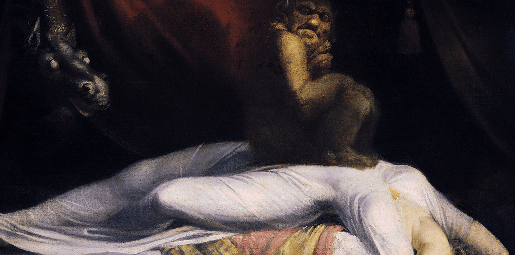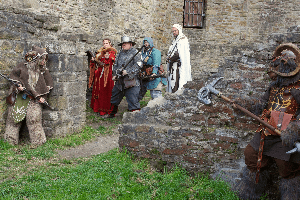
Combat readiness is more than simple surprise. In most D&D games surprise comes down to one side getting a few free actions at the beginning of combat and that’s it. But, surprise can be so much more than that. There’s a big difference between surprising a guard on watch and attacking him asleep in his bed. More than just the unconscious condition.
If you need to catch up on the Alternative Encounter Building series check out the previous post: Environment Design: Alternative Encounter Building III. And if you’re brand new, check out the first post: Alternative Encounter Building I: Challenge Rating.
A guard on watch is wearing his armor and holding a weapon or wearing one at his side. A sleeping guard doesn’t wear armor, wield a shield, and his weapon may be across the room. Those two encounters are fundamentally different and it’s all combat readiness.
As a DM ask this about your monsters and NPCs, “Are they expecting a fight?” A group of bandits entertaining themselves around the fire in the wee hours of the night are not. They’ve doffed their armor and traded swords and shields for food and wine.
2d6 Combat Readiness
- 2 > PCs Ambushed
- 3, 4 > PCs Unaware
- 5 – 9 > Equal Footing
- 10, 11 > Opponent Unaware
- 12 > Opponent Ambushed
You may be unclear on the difference between unaware and ambushed. Being unaware gives the side with advantage the benefit of a surprise round: a free round of attacks against the enemy.

Ambushers gain the same effect as an unaware opponent, with extra benefits. Ambushers have time to plan and prepare for opponents. They can lay traps, find advantageous terrain, and coordinate their attacks.
Opponents attack unaware parties with a surprise round. Ambushers coordinate attacks to neutralize the party’s spellcaster at the beginning of combat. Players will naturally want to turn an unaware opponent into an ambushed opponent. You can halt players from planning too much on an unaware opponent. Inform them know you’re making Perception checks for the baddies as they talk. It’s only a matter of time before the bad guys notice them.
Let’s roll a couple encounters for a classic, level seven, D&D party. We’ll combine CR, Odds, Environment, and Combat Readiness.
2d6 Encounter 1
- CR: @ Level (8)
- Odds: 1:1 Odds (5)
- Environment: Equal Footing (9)
- Combat Readiness: Opponent Unaware (10)
I decided on a vanilla humanoid encounter. We know the target CR is seven at a hard difficulty. The odds will also be even, so four baddies. I dropped into Kobold Fight Club and fiddled through a couple options. I decided on an encounter with three veterans and one orc war chief. I’ll reskin the latter to be a human. The environment is non-partial, so I won’t worry about any specifics for now. However, the party will get the drop on these guys. It won’t be a full-scale ambush, but the baddies will be doing something else. Let’s say they’re a hunting party that’s busy dressing game.
2d6 Encounter 2
- CR: @ Level (7)
- Odds: 1:1 Odds (7)
- Environment: Party Favored (10)
- Combat Readiness: Equal Awareness (9)
For this encounter I decided to do something a little more complex, oozes. Nothing changed in the encounter with regards to CR and Odds. With a few clicks I decided on a combat with two black puddings and two ochre jellies. I really wanted to use gelatinous cubes. But, the party is fighting in a favored environment, not a fortified environment.
What’s the difference? Well, the major advantage the PCs have is oozes are slow. They have a speed of 20 feet. Oozes also have a climb speed, EXCEPT for the gelatinous cube
The combat environment will have many 5 foot platforms that are 10 feet apart. Any PC with a 10+ Strength score can make that jump. I’d also add an easy Acrobatics check (DC 9) to make sure they can stick the landing and not tumble off in a random direction (1d8). The platforms are only 5 foot tall so no fall damage, just the risk of falling prone and giving the oozes advantage. A little risk vs. reward to add tension.
Conclusion
The best part? The two combat encounters took less than 10 minutes to formulate. Thank you for taking time to read this series, it’s been a real fun one to develop. We still have one more alternative encounter building topic to cover. We’ll be talking hit points and how awesome they are to adjust the difficulty and flavor of an encounter.
